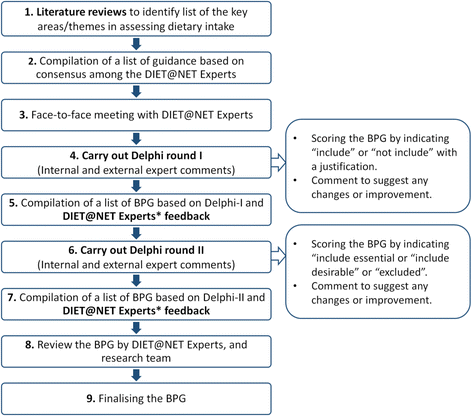DIET@NET: Best Practice Guidelines for dietary assessment in health research
- PMID: 29137630
- PMCID: PMC5686956
- DOI: 10.1186/s12916-017-0962-x
DIET@NET: Best Practice Guidelines for dietary assessment in health research
Abstract
Background: Dietary assessment is complex, and strategies to select the most appropriate dietary assessment tool (DAT) in epidemiological research are needed. The DIETary Assessment Tool NETwork (DIET@NET) aimed to establish expert consensus on Best Practice Guidelines (BPGs) for dietary assessment using self-report.
Methods: The BPGs were developed using the Delphi technique. Two Delphi rounds were conducted. A total of 131 experts were invited, and of these 65 accepted, with 48 completing Delphi round I and 51 completing Delphi round II. In all, a total of 57 experts from North America, Europe, Asia and Australia commented on the 47 suggested guidelines.
Results: Forty-three guidelines were generated, grouped into the following four stages: Stage I. Define what is to be measured in terms of dietary intake (what? who? and when?); Stage II. Investigate different types of DATs; Stage III. Evaluate existing tools to select the most appropriate DAT by evaluating published validation studies; Stage IV. Think through the implementation of the chosen DAT and consider sources of potential biases.
Conclusions: The Delphi technique consolidated expert views on best practice in assessing dietary intake. The BPGs provide a valuable guide for health researchers to choose the most appropriate dietary assessment method for their studies. These guidelines will be accessible through the Nutritools website, www.nutritools.org .
Keywords: Dietary assessment methods; Guidelines; Nutrition; Nutritional epidemiology; Public health.
Conflict of interest statement
Competing interests
The authors declare no competing financial interests. The University of Leeds is establishing a spin-out company, myfood24, for our new online dietary assessment tool. Professor Janet Cade is a director and shareholder of myfood24.
Publisher’s Note
Springer Nature remains neutral with regard to jurisdictional claims in published maps and institutional affiliations.
Figures
References
-
- Beaton GH, Burema J, Ritenbaugh C. Errors in the interpretation of dietary assessments. Am J Clin Nutr. 1997;65(4):1100S–7S. - PubMed
-
- Illner A-K, Freisling H, Boeing H, Huybrechts I, Crispim S, Slimani N. Review and evaluation of innovative technologies for measuring diet in nutritional epidemiology. Int J Epidemiol. 2012;41(4):1187–203. - PubMed
-
- Dietary Assessment Primer.: National Institutes of Health, National Cancer Institute, Bethesda, MD, USA. https://dietassessmentprimer.cancer.gov/. Accessed 22 Aug 2017.
Publication types
MeSH terms
Grants and funding
LinkOut - more resources
Full Text Sources
Other Literature Sources



